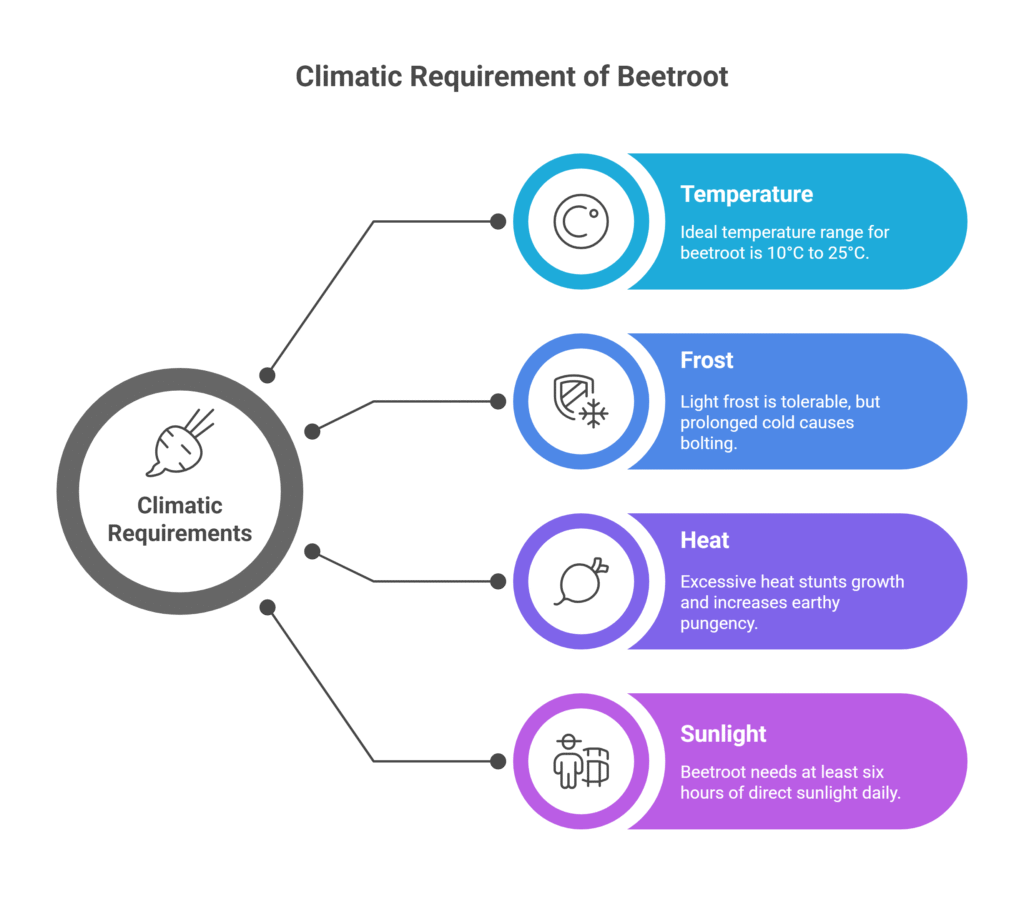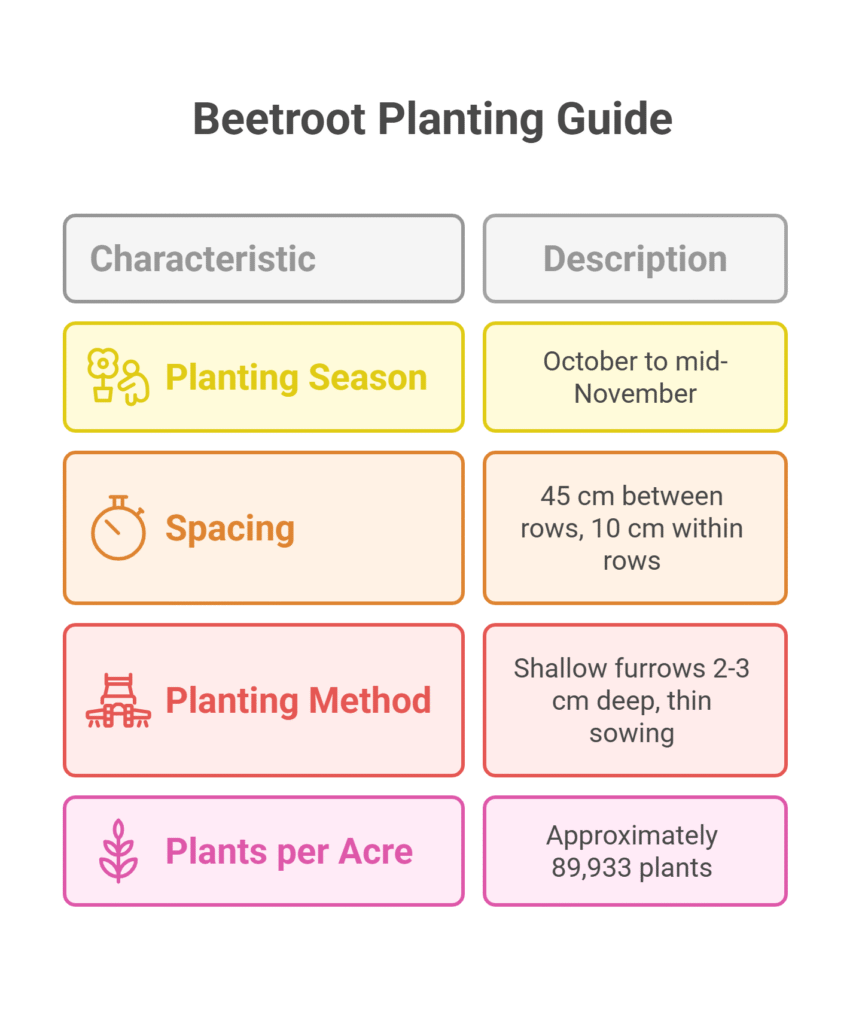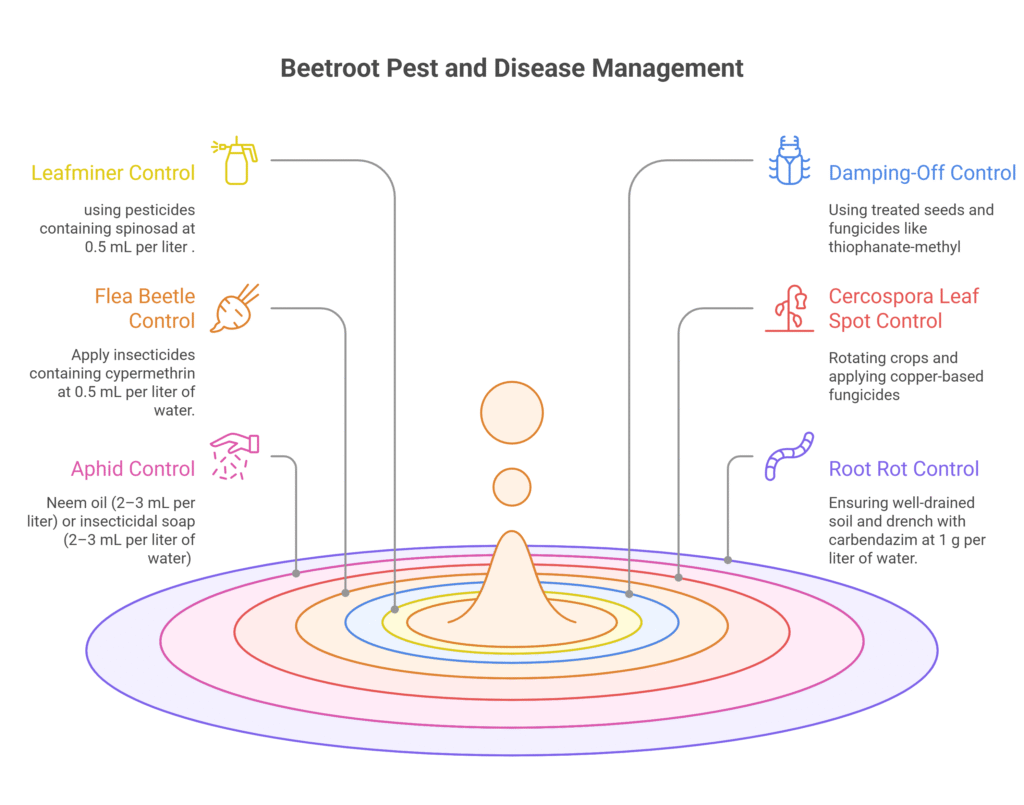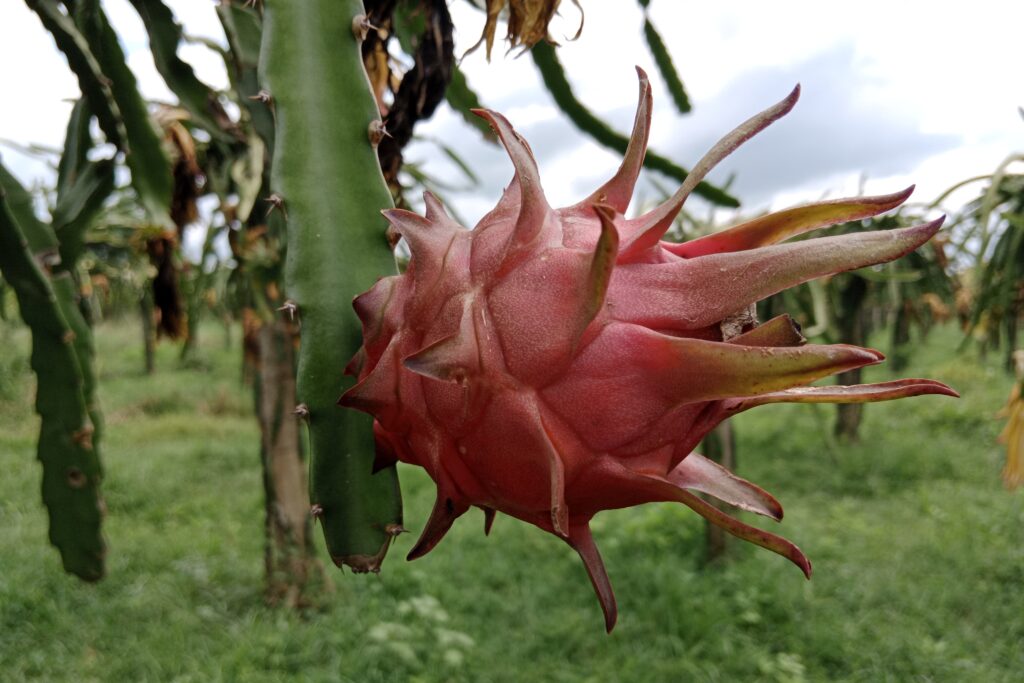Beetroot Farming
Beetroot (Beta vulgaris subsp. vulgaris), also known as table beet or garden beet, is a popular root vegetable grown for its nutritious taproot and greens. It is rich in vitamins, minerals, and antioxidants (like betalains).
Beetroot farming profit per acre is highly attractive due to its relatively low investment and impressive returns. With a total investment of just NRs. 48,000, farmers can generate an income of around NRs. 240,000, leading to a net profit of NRs. 192,000 per acre.
This translates into a remarkable return on investment (ROI) of 400% and a benefit-cost ratio (BCR) of 5.0, clearly showing that beetroot cultivation offers excellent financial rewards. Such profitability makes beetroot farming a viable option for both small- and large-scale farmers who are looking to maximize income with efficient resource use.
Land Preparation
Proper land preparation is essential for cultivating healthy, well-shaped beetroot roots. Start with deep plowing or digging to a depth of 30–40 cm to loosen the subsoil, improve drainage, and allow roots to penetrate easily. Follow this with 2–3 rounds of harrowing or rototilling to break down clods and create a fine, loose, and aerated soil structure.
Remove all stones, hard clumps, and debris, as these can cause roots to become forked, stunted, or misshapen. Finally, form raised beds or ridges about 15–20 cm high in areas prone to heavy rainfall or poor drainage to prevent waterlogging, while flat beds are suitable for lighter soils and drier regions.
Soil Type
The quality of a beetroot harvest is profoundly influenced by soil conditions, with poor soil often resulting in deformed or stunted roots. To prevent this, gardeners must avoid dense clay soils that compact easily and restrict growth. Instead, they should seek out or amend their garden beds to achieve a loose, well-aerated consistency that allows roots to expand freely.
Furthermore, maintaining a soil pH between 6.0 and 7.5 is critical, as high acidity hinders the plant’s ability to absorb nutrients. If a soil test reveals a pH that is too low, amending the earth with agricultural lime will neutralize the acidity, enhance the soil structure, and pave the way for vigorous growth and maximum yield.
Climatic Requirements
Beetroot is classified as a cool-season crop, achieving its best development within a moderate temperature range of 10°C to 25°C (50°F–77°F). While the plant can survive light frosts, prolonged exposure to cold below 10°C triggers a stress response known as bolting, where the plant prematurely produces a flower stalk, ruining the root for harvest.

Conversely, excessive heat is equally detrimental; when temperatures climb above 27°C (80°F), root growth is stunted, often leading to “zoning”—the formation of pale, tough rings within the beet—and an undesirable increase in earthy pungency. To synthesize the sugars necessary to develop its characteristic sweetness and achieve robust growth, beetroot is also highly dependent on full sun, requiring a minimum of six hours of direct exposure each day.
Major Cultivars
The choice of beetroot cultivar depends on the desired root characteristics, including shape, color, and the time required for maturity, allowing farmers to select varieties that best suit their market preferences and growing conditions.
| Variety Name | Description & Shape | Key Characteristics |
| Detroit Dark Red | Globular, deep red roots | Popular commercial variety; excellent internal color; good disease resistance. |
| Crosby Egyptian | Flattened-globe roots | Early-maturing variety; tolerates warmer conditions well. |
| Bull’s Blood | Dark red, sweet roots | Grown for both roots and striking deep red foliage; foliage is used as a salad green. |
| Chioggia | Heirloom variety (also known as Candy Cane) | Known for its distinctive concentric rings of red and white flesh. |
| Golden Beet | Yellow-orange skin and flesh; round shape | Sweeter than red varieties; does not “bleed” its color during cooking. |
| Forono | Cylindrical roots | Ideal for uniform slicing and processing (e.g., for pickling or canned slices). |
Propagation
Beetroot is propagated exclusively by seeds.
Seed Rate per Acre
The recommended seed rate for beetroots is approximately 5 to 8 kg per acre, depending on seed size, germination rate, and the desired spacing. Beetroot ‘seeds’ are actually dried fruit clusters, or multigerm seedballs, each containing 2–6 true seeds, which often results in multiple seedlings emerging from a single spot. Modern cultivars are also available as monogerm seeds, producing only one seedling per seed and thereby reducing the need for intensive thinning.
Planting
a). Planting Season
The best period for sowing beetroot is from October to mid-November.
b). Spacing
For optimal growth, beetroot should be spaced 45 cm between rows and 10 cm between individual plants within a row.

c). Planting Method
Beetroot seeds should be planted in shallow furrows 2–3 cm deep along prepared beds. Sow the seeds thinly, placing one seed every 2–3 cm, then cover lightly with fine soil or compost and gently firm the soil. Immediately after sowing, water uses a fine spray to prevent the seeds from being washed away.
d). Number of Plants per Acre
An acre of beetroot can support about 89,933 plants at a 45 cm × 10 cm spacing.
Intercropping
Beetroot, due to its relatively short growing season and upright growth habit, is well-suited for intercropping. It can be successfully grown alongside tall crops such as maize or sunflowers, which provide light shade in hot climates, as well as quick-maturing crops like radish, lettuce, or bush beans. However, intercropping with other root crops like carrots should be avoided, as they compete for the same below-ground space.
Irrigation
Germination
Beetroot seeds require consistently moist soil to ensure uniform germination, which typically occurs within 5–14 days. Light, frequent watering is ideal at this stage to keep the seedbed damp without washing away the seeds.
Establishment
Once seedlings emerge, irrigation can be reduced in frequency but should be deeper. This encourages the development of strong, healthy roots capable of supporting the plant throughout its growth.
Critical Stages
Maintaining consistent soil moisture is especially important during the root bulking stage. Drought stress at this time can result in tough, woody roots and may trigger premature bolting. At the same time, waterlogging should be avoided, as it can cause root rot and reduce yield quality.
Pre-Harvest
About 1–2 weeks before harvest, irrigation should be gradually reduced. This practice enhances the sweetness of the roots and improves their storability by preventing excess water accumulation.
Fertilizer and Manure Application for Beetroot
| Application Stage | Type | Details & Quantity |
| Before Planting | Organic Manure | Incorporate 20-25 tons of well-decomposed Farm Yard Manure (FYM) or compost per acre during land preparation. |
| Basal Application | Biofertilizers | Incorporate 800g each per acre of Azospirillum, PSB (Phosphate Solubilizing Bacteria), and Potash mobilizing bacteria. |
| Basal Application | Inorganic (NPK) | Apply half the dose of N and the full dose of P and K (25-30 kg of N, 50-60 kg P₂O₅, and 50-60 kg K₂O per acre). |
| Top-Dressing (4-5 weeks after sowing) | Inorganic (N) | Apply the remaining half dose of Nitrogen (25-30 kg N per acre) when the roots begin to bulb. |
| Additional Note | Boron | Beetroot is sensitive to boron deficiency. Apply boron as per soil test recommendations (often as a foliar spray) to prevent internal black spot. |
Weed Control
Weeds compete strongly with young beetroot plants, making timely control essential. The first weeding should be done carefully about 2–3 weeks after emergence to avoid damaging shallow roots, while the second weeding is often combined with thinning at 4–5 weeks. Applying a layer of organic mulch, such as straw or grass clippings, helps suppress weeds and conserve soil moisture. Pre-emergence herbicides can also be used, but they must be chosen carefully and applied strictly according to label instructions, as beetroot is sensitive to many chemicals.
Interculture Operation
Thinning is the most important interculture operation for beetroot. When seedlings reach 5–7 cm in height, usually 2–3 weeks after emergence, they should be thinned to the desired spacing of 5–10 cm by removing weaker seedlings and leaving the strongest in each cluster. This practice prevents overcrowding, which can lead to small, misshapen roots, and the removed seedlings are edible, making a nutritious addition to salads.
Flowering and Fruit Management
Bolting, or the premature production of a flower stalk, is undesirable in beetroot because it diverts energy away from root development, resulting in tough, woody, and inedible roots. This phenomenon reduces both yield and quality, making its management crucial for successful cultivation.
Bolting is typically triggered by exposure to cold temperatures during the young seedling stage, a process known as vernalization, or by environmental stress. To prevent bolting, farmers should avoid sowing too early in spring when cold spells are likely, choose bolt-resistant cultivars, and ensure consistent growth conditions, including adequate water and nutrients.
Pest and Disease Management
Common Pests
a). Leafminer
Larvae of leafminers tunnel into beetroot leaves, decreasing photosynthesis and creating visible trails. To stop more infection, impacted leaves should be taken out and destroyed. Applying neem oil at a concentration of 2-3 mL per liter of water or using pesticides containing spinosad at 0.5 mL per liter as directed on the label are two options for chemical control.
b). Aphids
Aphids can spread viral infections and eat by sucking sap from immature leaves, which can negatively impact plant growth. Neem oil (2–3 mL per liter) or insecticidal soap (2–3 mL per liter of water) can be used to control them. Another efficient and environmentally responsible strategy is to promote natural predators like lacewings and ladybugs.
c). Flea Beetles
Flea beetles chew small holes in leaves, which can stunt seedling growth. Protective measures include using row covers to prevent beetle access. If chemical intervention is needed, apply insecticides containing cypermethrin at 0.5 mL per liter of water, ensuring proper coverage and following safety guidelines on the label.

Common Diseases
a). Cercospora Leaf Spot
This disease appears as small, circular spots with reddish-brown margins on beetroot leaves, reducing photosynthetic activity and yield. Management includes crop rotation, removing affected leaves, and planting resistant varieties. For chemical control, apply copper-based fungicides such as copper oxychloride at 3–4 g per liter of water, spraying at 10–14-day intervals or as per label instructions.
b). Damping-Off
Particularly in soils with inadequate drainage, damping off can cause young seedlings to collapse and perish. Using treated seeds, keeping drainage adequate, avoiding overwatering, and maintaining good seedbed hygiene are all examples of preventive actions. To safeguard seedlings, fungicides such as thiophanate-methyl, which is 1 g per liter of water, can be sprayed on the soil or applied as a seed treatment.
c). Root Rots (e.g., Rhizoctonia)
Root rots cause decay of beetroot roots, particularly under waterlogged conditions. To manage this disease, avoid excessive irrigation, ensure well-drained soil, and practice crop rotation with non-host crops. Fungicides such as carbendazim at 1 g per liter of water can be applied to the soil or as a drench to reduce infection risk.
Harvesting
Maturity
Beetroots are generally ready for harvest 55 to 70 days after sowing, depending on the cultivar and growing conditions. Monitoring the crop regularly helps ensure harvest at the optimal stage.
Indicator
The roots are mature when they reach 1.5 to 3 inches (4–7 cm) in diameter. Harvesting roots larger than this can result in tough, woody, and less flavorful beetroots.
Harvesting Method
Using a fork or spade, remove the soil around the roots carefully, then hold the base of the greens and pull the plants out for harvesting. Avoiding injuring the roots, which can lower quality and shorten shelf life, requires careful handling.
Topping
After harvesting, twist off the leaf tops, leaving about 1–2 inches of stem attached. Avoid cutting into the root itself, as this can cause “bleeding” and negatively affect storage life.
Yield
The average yield of beetroot ranges from 10 to 15 tons per acre, depending on factors such as cultivar, soil fertility, irrigation, and overall crop management practices.
Cost of Investment per Acre for Beetroot Farming
| S.N. | Categories | Cost for Investment (NRs.) |
| 1 | Land Preparation | 15,000 |
| 2 | Seed | 1,000 |
| 3 | Sowing | 2,000 |
| 4 | Fertilizers and Manure | 8,000 |
| 5 | Irrigation | 5,000 |
| 6 | Weed Control (pre & post-emergence) | 3,000 |
| 7 | Pest & Disease Control | 3,000 |
| 8 | Harvesting | 6,000 |
| 9 | Miscellaneous Costs | 5,000 |
| Total Investment Cost | 48,000 |
Income per acre from beetroot farming
| Particulars | Estimated Yield / Acre (Kg) | Market Price (NRs / kg) | Total Income (NRs.) |
| Beetroot Yield | 12,000 | 20 | 240,000 |
| Total Income | 240,000 |
Analysis of Beetroot Farming Profit Per Acre
| Metric | Calculation | Value (NRs. or %) |
| Total Investment | 48,000 | |
| Total Income | 240,000 | |
| Net Profit | 240,000 – 48,000 | 192,000 |
| Return on Investment (ROI) | (192,000 / 48,000) × 100 | 400% |
| Benefit-Cost Ratio (BCR) | 240,000 / 48,000 | 5.0 |
The total investment required is NRs. 48,000, while the total income generated amounts to NRs. 240,000, resulting in a net profit of NRs. 192,000. The return on investment (ROI) is calculated at 400%, and the benefit-cost ratio (BCR) stands at 5.0, indicating high profitability.
Crop Calendar for Beetroot Farming
| Phase | Time Period (From Sowing) | Key Activities & Operations |
| Pre-Planting (Preparation) | 2–3 weeks before sowing | Land Preparation: Deep plowing (30–40 cm); 2–3 rounds of harrowing/rototilling; form raised beds (15–20 cm high) if needed. Soil Amendment: Apply 20–25 tons FYM/compost per acre; apply full P & K (50–60 kg P₂O₅ & K₂O) and half N (25–30 kg); add biofertilizers (800 g/acre each of Azospirillum, PSB, Potash mobilizer). |
| Sowing & Germination | Day 0 (Oct–mid Nov optimal) | Planting: Sow seeds 2–3 cm deep in shallow furrows; seed rate 5–8 kg/acre; spacing 45 cm between rows, 10 cm between plants after thinning. Initial Irrigation: Water immediately after sowing with fine spray to moisten seedbed. |
| Germination Stage | Week 1–2 | Maintain consistently moist soil for uniform germination; germination occurs in 5–14 days. |
| Early Growth (Seedling Stage) | Week 2–3 | First Weeding: Remove weeds carefully. Thinning: At 5–7 cm seedling height, thin to 10 cm spacing; weak thinnings edible. |
| Root Establishment | Week 3 onwards | Shift irrigation from light/frequent to deeper/less frequent for strong root growth. |
| Vegetative Growth & Root Bulking | Week 4–5 | Top-Dressing: Apply remaining half N (25–30 kg/acre). Second Weeding & Final Thinning: Combine both operations. Pest Monitoring: Scout for leafminers, aphids, flea beetles; apply neem oil (2–3 ml/L) if above threshold. |
| Critical Growth Stage | Throughout growth | Ensure consistent moisture; drought causes woody roots and bolting; avoid waterlogging to prevent rot. |
| Maturation & Pre-Harvest | Week 7–10 (55–70 DAS) | Irrigation: Gradually reduce 1–2 weeks before harvest to enhance sweetness and storability. Disease Monitoring: Check for Cercospora leaf spot; remove heavily infected leaves. |
| Harvest & Post-Harvest | Day 55–70 | Harvesting: Pull roots (4–7 cm diameter) after loosening soil with fork. Topping: Twist off tops, leaving 1–2 inches of stem; avoid cutting roots. Yield: 10–15 tons/acre (≈12,000 kg used for profit calculation). |
Sources
Food and Agriculture Organization (FAO)
University of California Agriculture & Natural Resources (UC ANR)
European Plant Protection Organization (EPPO)
Punjab Agricultural University (PAU)
Tamil Nadu Agriculture University (TNAU) – Agritech portal
Indian Council of Agricultural Research (ICAR)
Nepal Agricultural Research Council (NARC)
U.S. Department of Agriculture (USDA).
Ministry of Agriculture and Livestock Development (Nepal)
Disclaimer: This crop farming profits assume optimal conditions. Actual results may vary depending on climate, market prices, and farm management practices.



